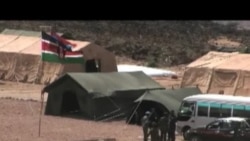PENTAGON —
The U.S. reaction to the attack by al-Shabab militants on a Kenyan mall has been cautious. The U.S. military, which has a small presence in Kenya, is reviewing its tactics and the work its teams are doing to train and equip Kenyan forces to go after the group.
The attack on Nairobi's Westgate mall is seen as retaliation for strikes by Kenyan forces on al-Shabab targets in Somalia.
Now, the U.S. is weighing how to respond and possibly boost assistance to the Kenyan army.
Defense analyst Seth Jones, testifying before a U.S. congressional panel, told lawmakers the approach should not end up helping al-Shabab to recruit more fighters.
“I think one thing we've got to be careful about is we don't encourage the Kenyans to overreact, conduct overt attacks within Somalia," said Jones.
Observers say images of Kenyans attacking Somalis with U.S. help would help al-Shabab gain sympathy - especially among young Somalis.
The U.S. has announced no plans to boost its presence in Kenya beyond the 150 U.S. troops who are now there, helping Kenyan forces build their capacity.
Al-Shabab has lost much of its territory in Somalia, but analyst Katherine Zimmerman says the Nairobi attack shows the U.S. and its partners have much more work to do.
“The strategy is working in parts but it's not going to work long-term. It's been able to hold off the rise of al-Shabab enough to keep it from growing in East Africa, but what we've seen is a resurgence there," said Zimmerman.
The Kenyans' response to the mall attack showed deficiencies in professionalism and command-and-control capabilities.
Reports say some first responders to the mall attack were seen looting rather than rescuing victims. And there are complaints of disorganized rescue efforts and heavy-handed tactics that resulted in victims' deaths.
Analyst Vanda Felbab-Brown says those types of tactical and technical issues should be easy for U.S. trainers to fix.
“In some ways, figuring how you knock down a door is far easier than figuring how you get broad intelligence. And the fact that the Kenyans struggled even with this tactical bit so much shows the real paucity of capacity despite our training so far," said Felbab-Brown.
For now, U.S. officials consider al-Shabab a regional threat with no real capacity to hit U.S. territory. However, memories of the 1998 U.S. embassy attacks in East Africa by al-Qaida - then also considered only a regional threat - are bolstering calls for closer attention and a strong - albeit low-key - U.S. response.
The attack on Nairobi's Westgate mall is seen as retaliation for strikes by Kenyan forces on al-Shabab targets in Somalia.
Now, the U.S. is weighing how to respond and possibly boost assistance to the Kenyan army.
Defense analyst Seth Jones, testifying before a U.S. congressional panel, told lawmakers the approach should not end up helping al-Shabab to recruit more fighters.
“I think one thing we've got to be careful about is we don't encourage the Kenyans to overreact, conduct overt attacks within Somalia," said Jones.
Observers say images of Kenyans attacking Somalis with U.S. help would help al-Shabab gain sympathy - especially among young Somalis.
The U.S. has announced no plans to boost its presence in Kenya beyond the 150 U.S. troops who are now there, helping Kenyan forces build their capacity.
Al-Shabab has lost much of its territory in Somalia, but analyst Katherine Zimmerman says the Nairobi attack shows the U.S. and its partners have much more work to do.
“The strategy is working in parts but it's not going to work long-term. It's been able to hold off the rise of al-Shabab enough to keep it from growing in East Africa, but what we've seen is a resurgence there," said Zimmerman.
The Kenyans' response to the mall attack showed deficiencies in professionalism and command-and-control capabilities.
Reports say some first responders to the mall attack were seen looting rather than rescuing victims. And there are complaints of disorganized rescue efforts and heavy-handed tactics that resulted in victims' deaths.
Analyst Vanda Felbab-Brown says those types of tactical and technical issues should be easy for U.S. trainers to fix.
“In some ways, figuring how you knock down a door is far easier than figuring how you get broad intelligence. And the fact that the Kenyans struggled even with this tactical bit so much shows the real paucity of capacity despite our training so far," said Felbab-Brown.
For now, U.S. officials consider al-Shabab a regional threat with no real capacity to hit U.S. territory. However, memories of the 1998 U.S. embassy attacks in East Africa by al-Qaida - then also considered only a regional threat - are bolstering calls for closer attention and a strong - albeit low-key - U.S. response.









